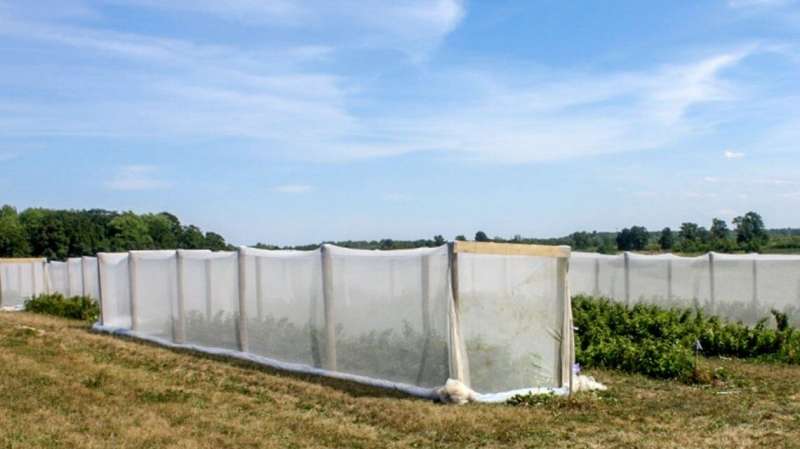New method to combat damage, help revive NY berry industry

At the Berry Patch farm in Stephentown, New York, big, ripe blueberries are waiting to be picked.
The farm is experiencing one of its best seasons to date thanks to better management of fall infestations of spotted wing drosophila (SWD), part of a research collaboration with Greg Loeb, professor of entomology at Cornell AgriTech, part of Cornell University's College of Agriculture and Life Sciences.
For the past few years, Loeb has been experimenting with a thin mesh covering, called exclusion netting, around berry crops as a means to prevent SWD infestation. The efficacy of the netting, at Berry Patch and in Cornell AgriTech research fields, is documented in a paper, "Factors Affecting the Implementation of Exclusion Netting to Control Drosophila Suzukii on Primocane Raspberry," published in the journal Crop Protection.
The Berry Patch, owned by Dale-Ila Riggs and Don Miles, has experienced the devastation SWD can cause in late ripening berries like blueberries and raspberries. In 2012, their blueberry crop was attacked, resulting in a loss of 40% of their crop.
Unlike a regular fruit fly, which attacks overripe fruit, SWD attacks the berry as it's ripening in the field. Females lay eggs in the berries; the eggs then hatch into larvae during the berry ripening phase, rendering the fruit unmarketable.
"We were doing our best to keep SWD at bay back then," said Riggs, who co-authored the paper. "But we also knew spraying all the time wasn't sustainable and it also didn't align with our business model."
Riggs heard about positive preliminary results of the netting and reached out to Loeb. The netting attaches to a frame and surrounds berry crops in order to minimize SWD contact with berries.
While the research supports the viability of exclusion netting in managing SWD, it also indicates that additional management techniques may need to coincide with the netting. For example, SWD outbreak infestations could still occur when workers move in and out of netted plantings.
"For this reason, if growers adopt exclusion netting, they must be prepared to manage outbreaks as necessary," said lead author Dara Stockton, a postdoctoral associate in Loeb's lab. "Still, the benefits of using the netting seem to outweigh the risks and research indicates that as few as one to two sprays per year may be sufficient."
Over the six years that Riggs has been using exclusion netting for her blueberries, she said she has never had to apply pesticides and has had less than 1% incidence of SWD each year. Another major benefit is cost: Riggs said that for her .1-acre high-tunnel raspberry plot, she spent roughly $300 on exclusion netting, whereas it would cost her $600 for a season's worth of pesticides.
"Ultimately, the quality of the berries at our farm is most rewarding," she said. "Under these nettings, we are breaking records and giving Oregon and Washington blueberry yields a run for their money."
More information: Dara G. Stockton et al, Factors affecting the implementation of exclusion netting to control Drosophila suzukii on primocane raspberry, Crop Protection (2020). DOI: 10.1016/j.cropro.2020.105191
Provided by Cornell University



















